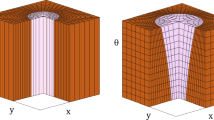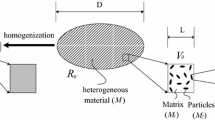Abstract
The paper deals with the homogenization of random heterogeneous media with arbitrarily shaped inclusions simulated with the extended finite element method (XFEM) coupled with Monte Carlo simulation (MCS). The implementation of XFEM is particularly suitable for this type of problems since there is no need to generate a new finite element mesh at each MCS. The inclusions are randomly distributed and oriented within the medium while their shape is implicitly modeled by the iso-zero of an analytically defined random level set function, which also serves as the enrichment function in the framework of XFEM. Homogenization is performed based on Hill’s energy condition and MCS. The homogenization involves the generation of a large number of random realizations of the microstructure geometry based on a given volume fraction of the inclusions and other parameters (shape, spatial distribution and orientation). The influence of the inclusion shape on the effective properties of the random media is highlighted. It is shown that the statistical characteristics of the effective properties can be significantly affected by the shape of the inclusions especially in the case of large volume fraction and stiffness ratio.























Similar content being viewed by others
References
Babuška I, Banerjee U (2012) Stable generalized finite element method (SGFEM). Comput Methods Appl Mech Eng 201–204:91–111
Baxter S, Hossain MI, Graham L (2001) Micromechanics based random material property fields for particulate reinforced composites. Int J Solids Struct 38(50):9209–9220
Belytschko T, Moës N, Usui S, Parimi C (2001) Arbitrary discontinuities in finite elements. Int J Numer Methods Eng 50(4):993–1013
Belytschko T, Gracie R, Ventura G (2009) A review of extended/generalized finite element methods for material modeling. Modell Simul Mater Sci Eng 17(4):1–24
Bordas S, Nguyen PV, Dunant C, Guidoum A, Nguyen-Dang H (2007) An extended finite element library. Int J Numer Methods Eng 71(6):703–732
Charalambakis N (2010) Homogenization techniques and micromechanics. A survey and perspectives. Appl Mech Rev 63(3)
Clément A, Soize C, Yvonnet J (2013) Uncertainty quantification in computational stochastic multiscale analysis of nonlinear elastic materials. Comput Methods Appl Mech Eng 254:61–82
Farsad M, Vernerey FJ, Park HS (2010) An extended finite element/level set method to study surface effects on the mechanical behavior and properties of nanomaterials. Int J Numer Methods Eng 84(12):1466–1489
Fries TP (2008) A corrected XFEM approximation without problems in blending elements. Int J Numer Methods Eng 75(5):503–532
Geers M, Kouznetsova V, Brekelmans W (2010) Multi-scale computational homogenization: trends and challenges. J Comput Appl Math 234(7):2175–2182
Greene MS, Xu H, Tang S, Chen W, Liu WK (2013) A generalized uncertainty propagation criterion from benchmark studies of microstructured material systems. Comput Methods Appl Mech Eng 254:271–291
Hashin Z (1983) Analysis of composite materials: a survey. J Appl Mech 50(2):481–505
Hill R (1963) Elastic properties of reinforced solids: some theoretical principles. J Mech Phys Solids 11(5):357–372
Hiriyur B, Waisman H, Deodatis G (2011) Uncertainty quantification in homogenization of heterogeneous microstructures modeled by XFEM. Int J Numer Methods Eng 88(3):257–278
Huyse L, Maes MA (2001) Random field modeling of elastic properties using homogenization. J Eng Mech 127(1):27–36
Kamiński M, Kleiber M (2000) Perturbation based stochastic finite element method for homogenization of two-phase elastic composites. Comput Struct 78(6):811–826
Krongauz Y, Belytschko T (1998) EFG approximation with discontinuous derivatives. Int J Numer Meth Eng 41(7):1215–1233
Lang C, Doostan A, Maute K (2013) Extended stochastic FEM for diffusion problems with uncertain material interfaces. Comput Mech 51:1031–1049
Legay A, Wang H, Belytschko T (2005) Strong and weak arbitrary discontinuities in spectral finite elements. Int J Numer Methods Eng 64(8):991–1008
Ma J, Temizer I, Wriggers P (2011) Random homogenization analysis in linear elasticity based on analytical bounds and estimates. Int J Solids Struct 48(2):280–291
Melenk JM, Babuška I (1996) The partition of unity finite element method: basic theory and applications. Comput Methods Appl Mech Eng 139(1):289–314
Miehe C, Koch A (2002) Computational micro-to-macro transitions of discretized microstructures undergoing small strains. Arch Appl Mech 72(4–5):300–317
Moës N, Dolbow J, Belytschko T (1999) A finite element method for crack growth without remeshing. Int J Numer Meth Eng 46:131–150
Moës N, Cloirec M, Cartraud P, Remacle JF (2003) A computational approach to handle complex microstructure geometries. Comput Methods Appl Mech Eng 192(28):3163–3177
Ostoja-Starzewski M, Wang X (1999) Stochastic finite elements as a bridge between random material microstructure and global response. Comput Methods Appl Mech Eng 168(1):35–49
Sethian JA (1999) Level set methods and fast marching methods, evolving interfaces in computational geometry, fluid mechanics, computer vision, and materials science. Cambridge university press, Cambridge
Sonon B, Francois B, Massart T (2012) A unified level set based methodology for fast generation of complex microstructural multi-phase RVEs. Comput Methods Appl Mech Eng 223–224:103–122
Stefanou G, Nouy A, Clément A (2009) Identification of random shapes from images through polynomial chaos expansion of random level set functions. Int J Numer Methods Eng 79(2):127–155
Sukumar N, Chopp DL, Moës N, Belytschko T (2001) Modeling holes and inclusions by level sets in the extended finite-element method. Comput Methods Appl Mech Eng 190(46):6183–6200
Talebi H, Zi G, Silani M, Samaniego E, Rabczuk T (2012) A simple circular cell method for multilevel finite element analysis. J Appl Math. doi:10.1155/2012/526846
Talebi H, Silani M, Bordas SP, Kerfriden P, Rabczuk T (2014) A computational library for multiscale modeling of material failure. Comput Mech 53(5):1047–1071
Torquato S (2002) Random heterogeneous materials: microstructure and macroscopic properties. Springer, New York
Tran A, Yvonnet J, He QC, Toulemonde C, Sanahuja J (2011) A multiple level set approach to prevent numerical artefacts in complex microstructures with nearby inclusions within XFEM. Int J Numer Methods Eng 85(11):1436–1459
Xu XF, Graham-Brady L (2005) A stochastic computational method for evaluation of global and local behavior of random elastic media. Comput Methods Appl Mech Eng 194(42):4362–4385
Yoon YC, Song JH (2014a) Extended particle difference method for weak and strong discontinuity problems: part I, derivation of the extended particle derivative approximation for the representation of weak and strong discontinuities. Comput Mech 53(6):1087–1103
Yoon YC, Song JH (2014b) Extended particle difference method for weak and strong discontinuity problems: part II, formulations and applications for various interfacial singularity problems. Comput Mech 53(6):1105–1128
Yuan Z, Fish J (2008) Toward realization of computational homogenization in practice. Int J Numer Methods Eng 73(3):361–380
Yvonnet J, Quang HL, He QC (2008) An XFEM/level set approach to modelling surface/interface effects and to computing the size-dependent effective properties of nanocomposites. Comput Mech 42(1):119–131
Zhao X, Bordas SP, Qu J (2013a) A hybrid smoothed extended finite element/level set method for modeling equilibrium shapes of nano-inhomogeneities. Comput Mech 52(6):1417–1428
Zhao X, Duddu R, Bordas SP, Qu J (2013b) Effects of elastic strain energy and interfacial stress on the equilibrium morphology of misfit particles in heterogeneous solids. J Mech Phys Solids 61(6):1433–1445
Zohdi TI, Wriggers P (2008) An introduction to computational micromechanics, 2nd edn., Lecture notes in applied and computational mechanics, vol 20, Springer, Heidelberg
Acknowledgments
This work is implemented within the framework of the research project “MICROLINK: Linking micromechanics-based properties with the stochastic finite element method: a challenge for multiscale modeling of heterogeneous materials and structures” - Action “Supporting Postdoctoral Researchers” of the Operational Program “Education and Lifelong Learning” (Action’s Beneficiary: General Secretariat for Research and Technology), and is co-financed by the European Social Fund (ESF) and the Greek State. The provided financial support is gratefully acknowledged. M. Papadrakakis acknowledges the support from the European Research Council Advanced Grant “MASTER–Mastering the computational challenges in numerical modeling and optimum design of CNT reinforced composites” (ERC-2011-ADG 20110209). Special thanks are also due to Professor Haim Waisman for providing the computer code of the XFEM model for inclusions of elliptical shape.
Author information
Authors and Affiliations
Corresponding author
Rights and permissions
About this article
Cite this article
Savvas, D., Stefanou, G., Papadrakakis, M. et al. Homogenization of random heterogeneous media with inclusions of arbitrary shape modeled by XFEM. Comput Mech 54, 1221–1235 (2014). https://doi.org/10.1007/s00466-014-1053-x
Received:
Accepted:
Published:
Issue Date:
DOI: https://doi.org/10.1007/s00466-014-1053-x




